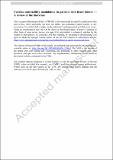| dc.contributor.author | Bazoukis, George | |
| dc.contributor.author | Saplaouras, Athanasios | |
| dc.contributor.author | Efthymiou, Polyxeni | |
| dc.contributor.author | Yiannikourides, Andronicos | |
| dc.contributor.author | Liu, Tong | |
| dc.contributor.author | Letsas, Konstantinos P. | |
| dc.contributor.author | Efremidis, Michael | |
| dc.contributor.author | Lampropoulos, Konstantinos | |
| dc.contributor.author | Xydonas, Sotirios | |
| dc.contributor.author | Tse, Gary | |
| dc.contributor.author | Armoundas, Antonis A. | |
| dc.date.accessioned | 2025-06-24T15:47:58Z | |
| dc.date.available | 2025-06-24T15:47:58Z | |
| dc.date.issued | 2024-02-23 | |
| dc.identifier.uri | https://hdl.handle.net/1721.1/159670 | |
| dc.description.abstract | Experimental in vivo and in vitro studies showed that electric currents applied during the absolute refractory period can modulate cardiac contractility. In preclinical studies, cardiac contractility modulation (CCM) was found to improve calcium handling, reverse the foetal myocyte gene programming associated with heart failure (HF), and facilitate reverse remodeling. Randomized control trials and observational studies have provided evidence about the safety and efficacy of CCM in patients with HF. Clinically, CCM therapy is indicated to improve the 6-min hall walk, quality of life, and functional status of HF patients who remain symptomatic despite guideline-directed medical treatment without an indication for cardiac resynchronization therapy (CRT) and have a left ventricular ejection fraction (LVEF) ranging from 25 to 45%. Although there are promising results about the role of CCM in HF patients with preserved LVEF (HFpEF), further studies are needed to elucidate the role of CCM therapy in this population. Late gadolinium enhancement (LGE) assessment before CCM implantation has been proposed for guiding the lead placement. Furthermore, the optimal duration of CCM application needs further investigation. This review aims to present the existing evidence regarding the role of CCM therapy in HF patients and identify gaps and challenges that require further studies. | en_US |
| dc.publisher | Springer US | en_US |
| dc.relation.isversionof | https://doi.org/10.1007/s10741-024-10390-1 | en_US |
| dc.rights | Article is made available in accordance with the publisher's policy and may be subject to US copyright law. Please refer to the publisher's site for terms of use. | en_US |
| dc.source | Springer US | en_US |
| dc.title | Cardiac contractility modulation in patients with heart failure — A review of the literature | en_US |
| dc.type | Article | en_US |
| dc.identifier.citation | Bazoukis, G., Saplaouras, A., Efthymiou, P. et al. Cardiac contractility modulation in patients with heart failure — A review of the literature. Heart Fail Rev 29, 689–705 (2024). | en_US |
| dc.contributor.department | Broad Institute of MIT and Harvard | en_US |
| dc.relation.journal | Heart Failure Reviews | en_US |
| dc.eprint.version | Author's final manuscript | en_US |
| dc.type.uri | http://purl.org/eprint/type/JournalArticle | en_US |
| eprint.status | http://purl.org/eprint/status/PeerReviewed | en_US |
| dc.date.updated | 2025-03-27T13:48:28Z | |
| dc.language.rfc3066 | en | |
| dc.rights.holder | The Author(s), under exclusive licence to Springer Science+Business Media, LLC, part of Springer Nature | |
| dspace.embargo.terms | Y | |
| dspace.date.submission | 2025-03-27T13:48:28Z | |
| mit.journal.volume | 29 | en_US |
| mit.license | PUBLISHER_POLICY | |
| mit.metadata.status | Authority Work and Publication Information Needed | en_US |
